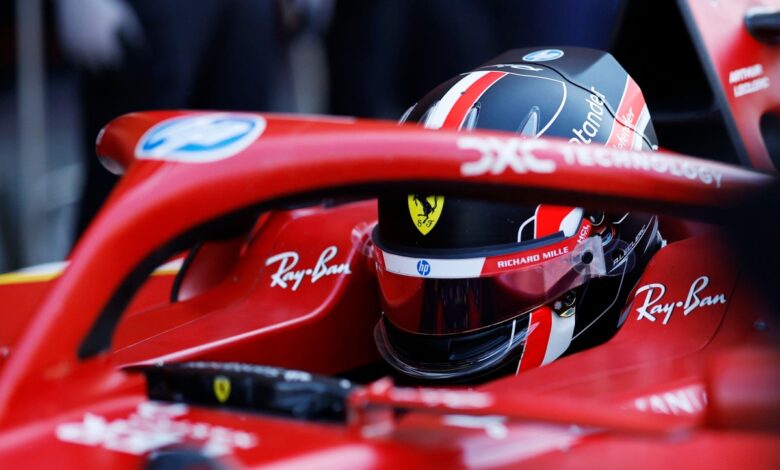F1 is giving rookies more FP1s in 2025 – who will get the chance?

There will be fresh blood aplenty in Free Practice 1 sessions this Formula 1 season, with teams required to run rookies twice in each of their cars (or entries, to be precise).
To be frank, a rookie’s FP1 outing is usually not the headliner of an F1 grand prix. Teams often leave it until the very last second to tick that box, leaving young drivers with what are effectively the most ‘perfunctory’ sessions of the year: something like FP1 in Abu Dhabi, in conditions well detached from those of the actual grand prix, or in Canada, on a street track with oft-suboptimal weather.
These rookie outings rarely include performance runs, with engineers preferring to steer young drivers away from any tasks that carry high damage risks. Which, as Andrea Kimi Antonelli‘s outing in Monza showed last year, isn’t the worst idea, given how motivated youngsters are to catch the eye.
As a result, rookie drivers are often delegated with aero rake running, which will sometimes come with an instruction to avoid the kerbs at all cost and stay below a certain speed on the straights.
Despite all this, the architects of the rule have enough evidence to deem it a success already. Take Franco Colapinto as an example – James Vowles has repeatedly acknowledged that it was the Argentine’s performance during first practice at Silverstone that had given him the confidence to promote the youngster into a race seat. Without the rule in place, there’s good reason to believe it would have been Mick Schumacher, not Colapinto, stepping into the Williams.
And while Oliver Bearman may have announced himself to the outside world in Saudi Arabia, he’d crucially impressed his current team boss Ayao Komatsu about half a year prior, when he’d carried out a perfect, mistake-free FP1 programme on a dusty track in Mexico. His Jeddah heroics needed only to reinforce Komatsu’s already held view of Bearman – and even a troubled F2 campaign wasn’t a meaningful obstacle to the Briton’s 2025 Haas contract.

Ayao Komatsu and Oliver Bearman
Photo by: Zak Mauger / Motorsport Images
While the rookie rule may be a burden for some teams – in most cases they would naturally prefer to maximise their race drivers’ time behind the wheel – it does work. There is a case to be made that it’s a significant factor behind a nearly one-third refresh of the F1 grid this year.
Rookie pass
It’s worth remembering that not every team will have to sideline one of its regulars on all four occasions this year, as some regular race drivers qualify as rookies. As per the rules, rookies are those with “not more than two championship races in their career”. So the likes of Antonelli, Gabriel Bortoleto and Isack Hadjar won’t have to cede their cars to anyone – they will keep the status until the Bahrain Grand Prix, so will tick off their car’s two rookie FP1s in Australia and China.
The same is true for Jack Doohan, even though he already raced in Abu Dhabi last year. His rookie status will expire after the Chinese Grand Prix – but the first two FP1 sessions will still take place before that, fulfilling the requirement. As a result, only their team-mates – Pierre Gasly, George Russell, Yuki Tsunoda and Nico Hulkenberg – will have to give up their cars during the season.
Another relevant detail is that F1 has retained the ‘Free Practice Super Licence’ rule, widening the scope of drivers eligible to participate beyond the current pool of superlicence holders.
A practice-only licence requires just 25 points rather than 40 – though a previous 300km in an F1 car is needed, for instance through a team’s TPC (Testing of Previous Cars) programme.
Who will drive for the top teams?
Rookie FP1s are most relevant for those teams with highly regarded prospects, and Red Bull almost always falls in that category. It’s easy to imagine that Christian Horner and Helmut Marko will want to evaluate Arvid Lindblad as much as possible, now that he has already amassed the requisite superlicence points and given that, with a successful F2 season, he could well end up on the grid in 2026 – if not earlier. Good FP1 outings would help fast-track him – and a runout in the spring could be logical. At the same time, Red Bull also has two other potentially relevant juniors in F2, Oliver Goethe and Pepe Marti.

Arvid Lindblad
Photo by: Red Bull Content Pool
On Ferrari’s end, the success of the Bearman experiment means, ironically, that there’s no obvious candidate this time. You’d expect Arthur Leclerc, Charles’s brother, to get another practice outing or two, but it looks as if Ferrari Driver Academy’s Dino Beganovic is being readied as next in line, having already secured 40 superlicence points. The team ran him in its private Bracelona test earlier this year, though it kept largely quiet about it.
Antonelli’s promotion means rookie sessions are less obvious to fill for Mercedes again – especially as its new reserve driver Valtteri Bottas exceeds the rookie criterion by 250 starts or so. Frederik Vesti will probably get the nod.
McLaren is in a similar situation. Last year, IndyCar driver Pato O’Ward popped up in practice – as did Ryo Hirakawa, whose outing in Abu Dhabi was a surprise to many. Hirakawa is no longer an option, having aligned with Alpine instead, whereas O’Ward will surely get another session or two. There’s also surely a possibility McLaren would want to see what it’s got in junior Ugo Ugochukwu, whose win in Macau last year pushed him past the required points threshold.
What about the rest?
Aston Martin is likely to give all four of its rookie practice outings to Felipe Drugovich, who’s re-signed as the team’s reserve driver.
Alpine won’t have too much of an issue finding an appropriate candidate either. In addition to the aforementioned Hirakawa, it now has Paul Aron on its books – and already ran him in the post-season young driver test last year.
Racing Bulls only needs to check off two sessions, thanks to Hadjar’s promotion. Lindblad will likely be in the car, while – given the ongoing relationship with Honda – there’d be logic in deploying Ayumu Iwasa in Japan again, as the team did last year.
There is considerably less clarity about the three remaining teams.

Ritomo Miyata
Photo by: Eric Le Galliot
At Haas you’d certainly expect Toyota protege Ritomo Miyata to drive, given he already had a TPC outing at Jerez in January and has the requisite licence points through his titles in Japan. Also in the picture here is Pietro Fittipaldi, who remains a rookie by regulation despite his two starts in 2020 – though his role at Haas for 2025 isn’t confirmed as it stands. Oliver Bearman, thanks to his three stand-in starts last year, no longer fulfills the quota.
Luke Browning is best-positioned to get some more FP1 sessions at Williams, especially given it’s a post-Colapinto Williams that has also split with another junior in Zak O’Sullivan.
At Sauber it looks like a clean slate. Long-time protege Theo Pourchaire has been released, but last year he was already watching from the sidelines as Robert Shwartzman, highly rated by Mattia Binotto, drove the car instead. The Russian-Israeli driver, however, is now starting his new racing life in the US as an IndyCar driver, so a surprise outside candidate would make sense here.
In this article
Oleg Karpov
Formula 1
Ryo Hirakawa
Frederik Vesti
Arthur Leclerc
Paul Aron
Dino Beganovic
Arvid Lindblad
Be the first to know and subscribe for real-time news email updates on these topics





